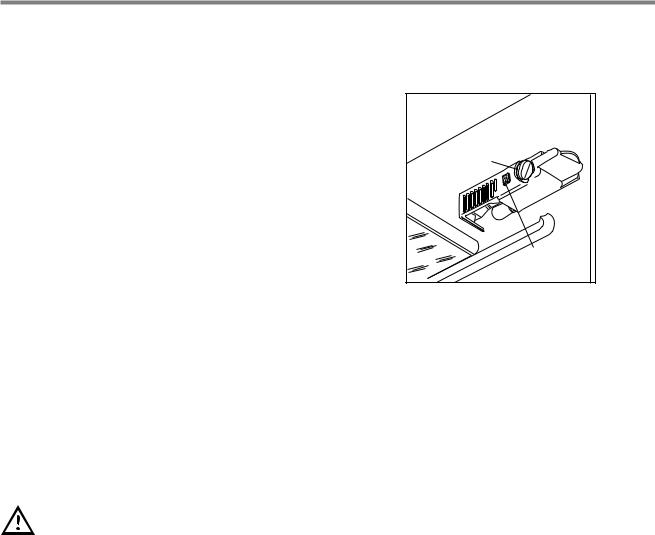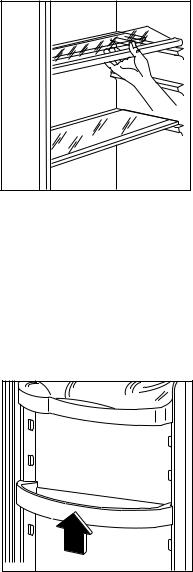Zanussi ZSS 7/5 W, ZSS 7/5 X User Manual

FRIDGE-FREEZER
ZSS 7/5 W ZSS 7/5 X
INSTRUCTION BOOKLET
2222712-99

 Important Safety Instructions
Important Safety Instructions
These warnings are provided in the interests of your safety. Ensure that you understand them all before installing or using this appliance. Your safety is of paramount importance. If you are unsure about any of the meanings of these warnings contact the Customer Care Department.
Prior to Installation
•Check the appliance for transport damage. Under no circumstance should a damaged appliance be installed. In the event of damage please contact your retailer.
Installation
•This appliance is heavy. Care should be taken when moving it.
•It is dangerous to alter the specifications or attempt to modify this product in any way.
•Ensure that the appliance does not stand on the electrical supply cable. Important: if the supply cable is damaged, it must be replaced by a cable available from the manufacturer or your local Service Force Centre.
•Any electrical work required to install this appliance should be carried out by a qualified electrician or competent person.
•Parts which heat up should not be exposed. Whenever possible, the back of the appliance should be close to a wall, but leaving the required distance for ventilation, as states in the installation instructions.
•The appliance should be left for 2 hours after installation before it is turned on, in order to allow the refrigerant to settle.
Refrigerant
•The refrigerant isobutane (R600a) is contained within the refrigerant circuit of the appliance, a natural gas with a high level of environmental compatibly, which is nevertheless flammable.
•During transportation and installation of the appliance, be certain that none of the components of the refrigerant circuit become damaged.
•If the refrigerant circuit should become damaged:
-avoid open flames and sources of ignition.
-thoroughly ventilate the room in which the appliance is situated.
General Safety
•This appliance contains hydrocarbons in its cooling unit; maintenance and recharging must therefore only be carried out by authorised technicians.
•Take utmost care when handling your appliance so as not to cause any damages to the cooling unit with consequent possible fluid leakages.
•The appliance must not be located close to radiators or boilers.
•Avoid prolonged exposure of the appliance to direct sunlight.
•Do not use other electrical appliances (such as ice cream makers) inside of refrigerating appliances.
During Use
•This appliance is designed for domestic use only, specifically for the storage of edible foodstuffs only. It is not intended for commercial or industrial use.
•Containers with flammable gases or liquids can leak at low temperatures. Do not store any containers with flammable materials, such as spray cans, fire extinguisher refill cartridges etc. in the refrigerator.
•Frozen food should not be refrozen once it has thawed out.
•Do not place carbonated or fizzy drinks in the freezer compartment.
•Ice lollies can cause ‘frost/freezer burns’ if consumed straight from the star compartement.
•Do not remove items from the freezer compartement if your hands are damp/wet, as this could cause skin abrasions or frost/freezer burns.
•Bottles and cans must not be placed in the freezer compartment they can burst when the contents freeze.
•Manufacturers’ recommended storage times should be adhered to.Refer to relevant instructions.
Child Safety
•Do not allow children to tamper with the controls or play with the product.
•There is a risk of suffocation! Keep packaging material away from children!
Maintenance and Cleaning
•Before cleaning, always switch off the appliance and disconnect from the electrical supply.
•When unplugging always pull the plug from the mains socket, do not pull on the cable.
2

Servicing
•This product should be serviced by an authorised engineer and only genuine spare parts should be used.
•Under no circumstances should you attempt to repair the appliance yourself.Repairs carried out by inexperienced persons may cause injury or serious malfunctioning. Contact your local Service Force Centre.
At the end of the Appliance Life
•When disposing of your appliance use an authorised disposal site.
•Remove the plug and ensure that any locks or catches are removed, to prevent young children being trapped inside.
Contents
Instructions for the User
Important Safety Instructions . . . . . . . . . . . . . . . .2
Operation . . . . . . . . . . . . . . . . . . . . . . . . . . . . . . . .4
Before use . . . . . . . . . . . . . . . . . . . . . . . . . . . . . . . .4 Setting the temperature . . . . . . . . . . . . . . . . . . . . . .4
The Refrigerator Compartment
Fresh food refrigeration . . . . . . . . . . . . . . . . . . . . . .4 The door shelves . . . . . . . . . . . . . . . . . . . . . . . . . . .5
Helpful hygiene tips . . . . . . . . . . . . . . . . . . . . . . . . .5
The Freezer Compartment |
5 |
Freezing fresh food . . . . . . . . . . . . . . . . . . . . . . . . .5 Frozen food storage . . . . . . . . . . . . . . . . . . . . . . . . .5
Some useful hints for freezing . . . . . . . . . . . . . . . . .6
Thawing . . . . . . . . . . . . . . . . . . . . . . . . . . . . . . . . . .6 Making ice cubes . . . . . . . . . . . . . . . . . . . . . . . . . . .6
Normal Operating Sounds . . . . . . . . . . . . . . . . . . . .6
Health and Safety Guidelines . . . . . . . . . . . . . . . .7
Defrosting . . . . . . . . . . . . . . . . . . . . . . . . . . . . . . . .8
Maintenance and Cleaning . . . . . . . . . . . . . . . . . .9
Internal cleaning . . . . . . . . . . . . . . . . . . . . . . . . . . . .9
External cleaning . . . . . . . . . . . . . . . . . . . . . . . . . . .9
Changing the light bulb . . . . . . . . . . . . . . . . . . . . . .9 When the appliance is not in use . . . . . . . . . . . . . . .9
Something Not Working? . . . . . . . . . . . . . . . . . .10
Service and Spare Parts . . . . . . . . . . . . . . . . . . .11
Customer Care Department . . . . . . . . . . . . . . . . .11
Guarantee Conditions . . . . . . . . . . . . . . . . . . . . .12
Instructions for the Installer
Technical Specifications . . . . . . . . . . . . . . . . . . .13
Installation . . . . . . . . . . . . . . . . . . . . . . . . . . . . . .13
Positioning . . . . . . . . . . . . . . . . . . . . . . . . . . . . . . .13
Aligning the appliance top with the other
kitchen units . . . . . . . . . . . . . . . . . . . . . . . . . . . . . .14
Fitting the appliance under the
kitchen work surface . . . . . . . . . . . . . . . . . . . . . . .14
Electrical Connection . . . . . . . . . . . . . . . . . . . . .15
3

Operation
Before use
Remove all securing tapes. Wash inside the appliance with lukewarm water and bicarbonate of soda (5 ml to 0.5 litre of water). Do not use soap or detergent as the smell may linger. Dry thoroughly.
Setting the temperature
The temperature inside the refrigerator is regulated by a thermostat control knob with 6 temperature positions and one «OFF» (O) position.
Position 1 = minimum coldness Position 6 = maximum coldness
Turn the thermostat control knob to the required position.
An intermediate position is usually the most suitable, although the temperature will be affected by:
•Room temperature
•How often the door is opened
•How much food is stored
•Position of the appliance
In determining the correct temperature control setting all these factors have to be considered and some experimentation may be necessary.
When altering the temperature setting, allow 24 hours for the temperature to stablise before making further changes.
Important
During prolonged periods of abnormally hot weather, if the thermostat is set on too high a number, the cooling system may operate continuously and the fridge cooling plate may not defrost. Turning the knob to a lower number will cause the automatic defrosting to resume.
Low room temperature switch
The appliance is designed to operate in room temperatures of 16°C to 32°C, or down to 10°C if the low room temperature switch is switched on. The low room temperature switch should be depressed when the room temperature drops below 16°C (the incorporated lamp will illuminate). If the room temperature drops below the above figures the temperature in the freezer may rise above -18°C, then safe storage of frozen food can no longer be guaranteed. It is most likely that the low room temperature switch will need to be depressed throughout the winter to allow for low overnight temperatures. No damage can be caused by leaving the switch in this position for a period of time but energy will be wasted.
A.Thermostat dial
B.Low room temperature switch
A |
B |
D325 |
The refrigerator compartment
Fresh food refrigeration
The coldest area of the refrigerator is the lower part, above the salad bin.
To obtain the best performance, do not store warm food or evaporating liquids in the refrigerator; do cover or wrap the food, particularly if it has a strong flavour.
Do not cover the shelves with any protective material, such as paper, cardboard or plastic, which may obstruct the air circulation through them.
To help you use your refrigerator correctly, here are some more useful hints:
Raw meat (beef, pork, lamb & chicken or poultry): wrap in polythene bags and place on top of the salad bin.
Meat can only be stored safely in this way for one or two days at the most.
Fruit & vegetables: these should be thoroughly cleaned and placed in the bottom salad bin.
Butter & cheese: these should be placed in special airtight containers or wrapped in aluminium foil or polythene bags to exclude as much air as possible.
Milk bottles: these should have a cap and should be stored in the bottle rack on the door.
4

The walls of the refrigerator are equipped with runners so that shelves can be positioned as desired.
For better use of space, the front half-shelf can lie over the rear one (see fig.).
D338
The door shelves
To permit storage of food packages of various sizes, the central door shelf can be adjusted in height.
To do this proceed as in the figure.
For more thorough cleaning, the top door shelf and the bottle shelf can be removed by pulling them in the director of the arrow, then refitting them in position.
PR187 |
Helpful hygiene tips
•Always wash your hands with soapy water and dry them with a clean towel before handling food.
•Keep work surfaces clean and avoid cross contamination by not using the same work surface for raw and cooked food without washing it thoroughly in between.
•Use clean kitchen roll wherever possible for clearing up food. If you use a dishcloth be sure to boil it frequently.
•Regularly remove suspect food from your refrigerator and clean the interior with a solution of bicarbonate of soda in warm water (5 ml to 0.5 litre of water). Never allow spills to dry and harden.
•Regularly check the refrigerator door seal to ensure that it is clean and free from debris.
•Make sure that food is used before its «best before» date.
•Cool food as quickly as possible but don't place in refrigerator or freezer until cool. (Leave food in a place as cool as possible in order that it can be placed in the refrigerator or freezer without delay).
•Do not store food uncovered.
•Do not mix raw and cooked meat, they must be in separate containers. Take care not to let the meat juices drip onto other food. If the meat does drip, remove everything and clean thoroughly.
The freezer compartment
Freezing fresh food
When starting up the appliance for the first time or after a period of non use, position the thermostat to a medium setting (3 or 4) and leave for at least 4 hours before placing the food to be frozen inside.
If you wish to fast-freeze a quantity of fresh food, press the ambient switch (light on) located near the thermostat knob. Leave it on this position for 24 hours before placing in the food and set it back to normal position 24 hours after placing the fresh food in the freezer.
If the switch is already depressed no further adjustment is required.
The products for freezing should be placed in the upper drawer and then transferred to the lower drawers so that the compartment is left free for the next freezing operation.
The maximum freezing capacity is 3 kg/24 hours. Never exceed the quantity indicated in one freezing batch.
Frozen food storage
Storing ready-frozen foods is quite straightforward. The packs can be placed beside each other or on top of each other.
In the first compartment, produce must only be stacked up to the mark on the drawer to ensure air circulation is not obstructed.
You are strongly advised to place ready-frozen food in the compartment as quickly as possible after purchase. Also ensure that the external packaging is intact.
Packaging which is swollen or has traces of refrozen water droplets on the pack could indicate that the product has not been kept at a suitable temperature and that it may have lost its original quality. Partially thawed food must not be refrozen, it must be consumed within 24 hours. Never exceed the storage times indicated.
Do not open the freezer door too often and do not leave open longer than necessary.
5
